Answers¶
0. Some setup¶
Import numpy for numerics and pyplot for visualisation¶
import numpy as np
import matplotlib.pyplot as plt
Define some useful constants¶
echarge = 1.60217662e-19 # electron charge
emass = 9.10938356e-31 # electron mass
vperm = 1.25663706212e-6 # vacumm permittivity
1. Defining some vector products¶
Define some vectors for testing¶
v1 = np.array([1.0, 2.0, 3.0])
v2 = np.array([4.0 ,5.0, 6.0])
v3 = np.array([7.0 ,8.0, 9.0])
1.a. Dot product¶
def dot(v1, v2):
return (v1[0]*v2[0]) + (v1[1]*v2[1]) + (v1[2]*v2[2])
1.b. Testing the dot product¶
check1 = 'Passed' if (dot(v1, v2) == 32.0) else 'Failed'
print(f'Check 1: {check1}')
check2 = 'Passed' if (dot(v1, v3) == 50.0) else 'Failed'
print(f'Check 2: {check2}')
check3 = 'Passed' if (dot(v2, v3) == 122.0) else 'Failed'
print(f'Check 3: {check3}')
Check 1: Passed
Check 2: Passed
Check 3: Passed
1.c. Cross product¶
def cross(v1, v2):
x = (v1[1]*v2[2]) - (v1[2]*v2[1])
y = (v1[2]*v2[0]) - (v1[0]*v2[2])
z = (v1[0]*v2[1]) - (v1[1]*v2[0])
return np.array([x, y, z])
1.d. Testing the cross product¶
check1 = 'Passed' if (cross(v1, v2) == np.array([-3, 6, -3])).all() else 'Failed'
print(f'Check 1: {check1}')
check2 = 'Passed' if (cross(v1, v3) == np.array([-6, 12, -6])).all() else 'Failed'
print(f'Check 2: {check2}')
check3 = 'Passed' if (cross(v2, v3) == np.array([-3, 6, -3])).all() else 'Failed'
print(f'Check 3: {check3}')
Check 1: Passed
Check 2: Passed
Check 3: Passed
2. Visualising some magnetic fields¶
2.a. Defining some field functions¶
def Bfield_constant(pos, t):
return np.array([0.0, 0.0, 1.0])
def Bfield_spacevarying(pos, t):
return np.array([0.0, 0.0, 1/np.sqrt(dot(pos, pos))])
def Bfield_timevarying(pos, t):
return np.array([0.0, 0.0, np.cos(t*(2*np.pi))])
2.b. Defining a function to generate a grid of points parrallel to yz-plane¶
def gen_grid(x, y0, z0, ymax, zmax, dyz):
num_ys = round((ymax-y0)/dyz)
ymax = y0 + num_ys*dyz # adjust ymax if (ymax - ymin) incompatible with dyz
num_zs = round((zmax-z0)/dyz)
zmax = z0 + num_zs*dyz # adjust ymax if (zmax - zmin) incompatible with dyz
points = []
for i in range(num_ys):
for j in range(num_zs):
points.append(np.array([x,
y0 + (dyz/2.0) + (i*dyz),
z0 + (dyz/2.0) + (j*dyz)]))
return points
Making a few plots to test gen_grid¶
def plot_grid(xyz):
x, y, z = zip(*tuple(xyz))
plt.figure(figsize=(9,6))
plt.scatter(y, z, s=10, c='b') # s for size, c for color
plt.xlabel(r'$y$', fontsize=20)
plt.ylabel(r'$z$', fontsize=20)
plt.show()
grid = gen_grid(0, -2, -2, 2, 2, 0.2)
plot_grid(grid)
grid = gen_grid(0, 0, 0, 5, 10, 0.2)
plot_grid(grid)
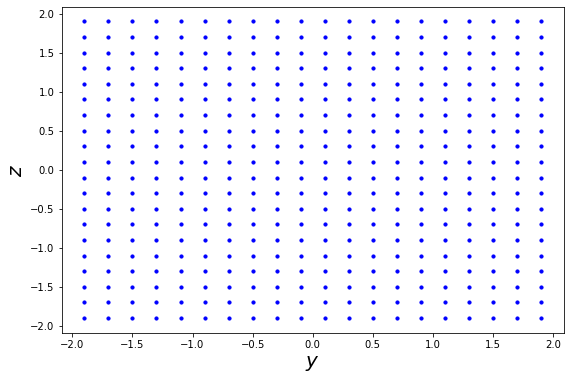
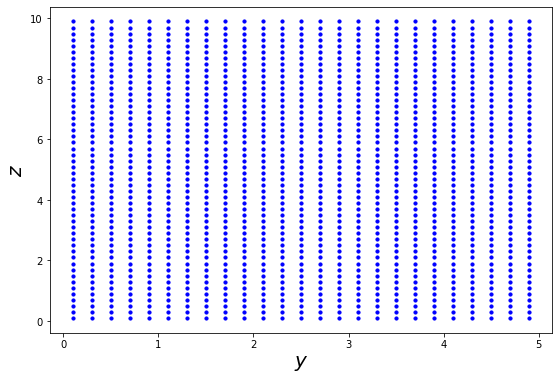
2.c. Visualizing the magnetic fields¶
def plot_Bfield(Bfield_function, xyz, t, title=None):
x, y, z = zip(*tuple(xyz))
Bvecs = [Bfield_function(pos, t) for pos in xyz]
Bx, By, Bz = zip(*tuple(Bvecs))
plt.figure(figsize=(9,6))
plt.quiver(y, z, By, Bz, scale=40.0)
plt.xlabel(r'$y$', fontsize=20)
plt.ylabel(r'$z$', fontsize=20)
if not title is None:
plt.title(title, fontsize=25)
plt.show()
grid = gen_grid(0, -2, -2, 2, 2, 0.2)
plot_Bfield(Bfield_constant, grid, 0, 'constant')
plot_Bfield(Bfield_spacevarying, grid, 0, 'space-varying')
plot_Bfield(Bfield_timevarying, grid, 0.0, 'time-varying, $t=0.0$')
plot_Bfield(Bfield_timevarying, grid, 0.25, 'time-varying, $t=0.25$')
plot_Bfield(Bfield_timevarying, grid, 0.5, 'time-varying, $t=0.5$')
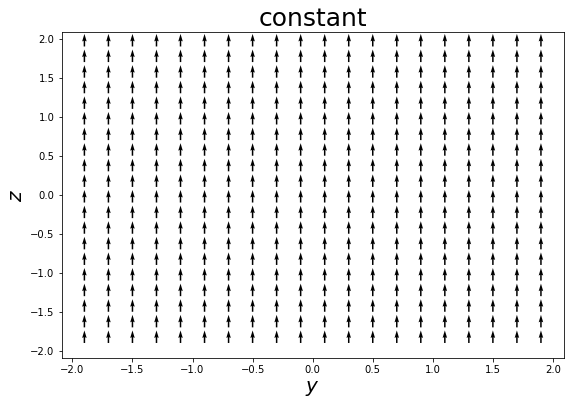
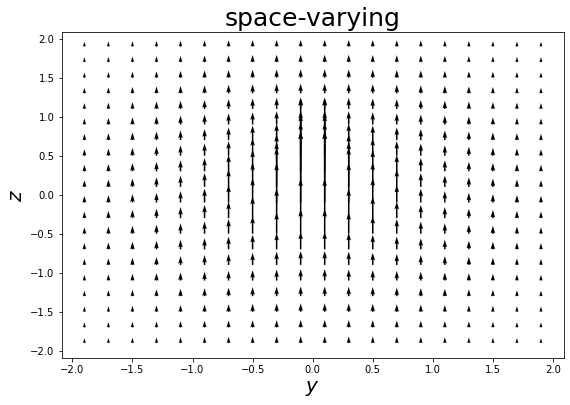
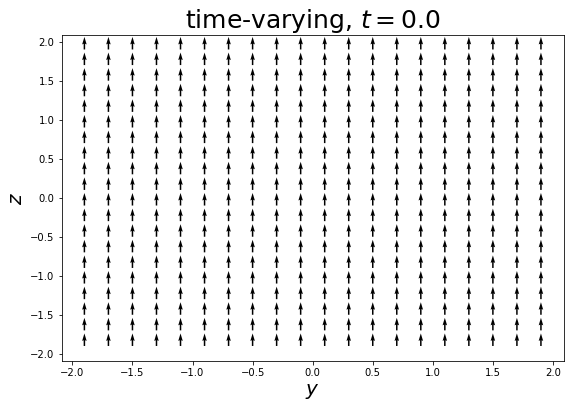
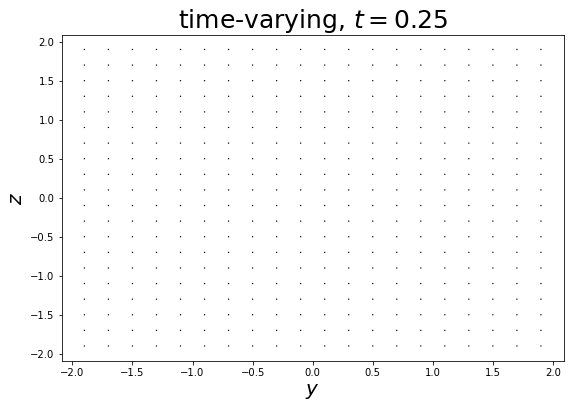
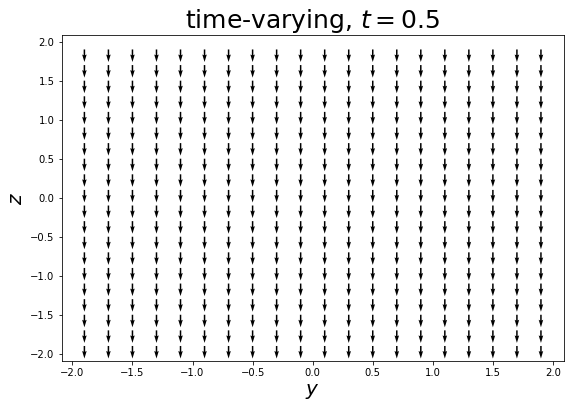
3. Writing and testing the integrator for the vector differential equation¶
3.a. Writing the integrator¶
def euler(vec_init, t_init, t_final, dt, diff_func, *args, **kwargs):
del_t = t_final - t_init # total duration to solve for
n_dt = round(del_t/dt)
dt = del_t/n_dt # adjust dt if (t_final - t_init) incompatible with dt
t = t_init
vec = vec_init
ts, vecs = [t], [vec] # initialise the output lists with the initial values as first element
for i in range(n_dt):
dvec = diff_func(vec, t, *args, **kwargs) # get the change in the vector at this step
vec = (vec + (dvec*dt)) # update vec according to the change calculated above
t += dt
ts.append(t)
vecs.append(vec) # add the new values to the output lists
return ts, vecs
3.b. Testing with 1st order differential equation¶
def diff_func(vec, t, const): # simple first order case
return const*vec
const = 2.0
t_init = 0.0
t_final = 2.0
dt = 0.01
vec_init = np.array([1.0]) # boundary condition - the function takes value 1.0 at t_init
ts, vecs = euler(vec_init, t_init, t_final, dt, diff_func, const=const)
y, = zip(*tuple(vecs)) # restructure output for plotting
### plotting ###
plt.figure(figsize=(9,6))
plt.plot(ts, y, c='b', label='numeric')
plt.plot(ts, np.exp(const*np.array(ts)), c='r', label='exact')
plt.xlabel('$t$', fontsize=20)
plt.ylabel('$exp(kt)$', fontsize=20)
plt.title('First order, $k=2.0$', fontsize=25)
plt.legend(loc='best', fontsize=15)
plt.show()
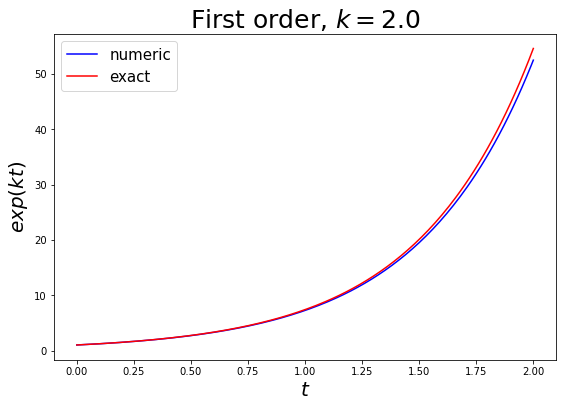
3.c. Testing with 2nd order differential equation¶
def diff_func(vec, t, const): # 2nd order case
vec_length = len(vec)
return np.concatenate((vec[vec_length//2:], (const**2)*vec[:vec_length//2])) # put function value and 1st derivative together in a single vector
const = 2.0
t_init = 0.0
t_final = 2.0
dt = 0.01
vec_init = np.array([1.0, const]) # boundary condition - the function and 1st derivative take values 1.0 and k at t_init respectively
ts, vecs = euler(vec_init, t_init, t_final, dt, diff_func, const=const)
y, dy = zip(*tuple(vecs)) # restructure output for plotting
### plotting ###
plt.figure(figsize=(9,6))
plt.plot(ts, y, c='b', label='numeric')
plt.plot(ts, np.exp(const*np.array(ts)), c='r', label='exact')
plt.xlabel('$t$', fontsize=20)
plt.ylabel('$exp(kt)$', fontsize=20)
plt.title('2nd order, $k=2.0$', fontsize=25)
plt.legend(loc='best', fontsize=15)
plt.show()
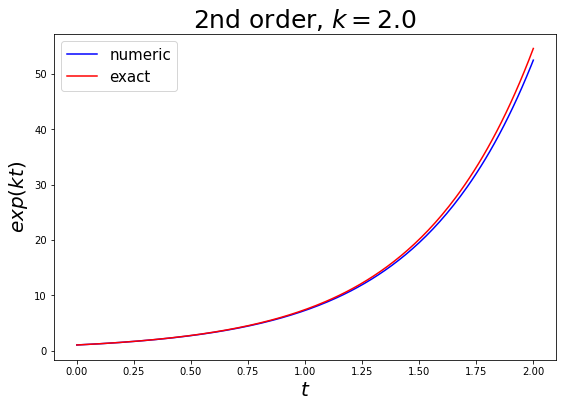
4. Simulate a charged test particle moving in a magnetic field¶
Representing the particle¶
def get_particle():
return {'charge' : echarge,
'mass' : emass,
'pos' : np.array([0.0, 0.0, 0.0]),
'vel' : np.array([1.0e11, 0.0, 0.0])}
4.a. Writing the differential equation¶
def diff_func(vec, t, mass, charge, Bfield_function):
vec_length = len(vec)
pos = vec[:vec_length//2]
vel = vec[vec_length//2:]
dpos = vel
dvel = (charge/mass)*cross(vel, Bfield_function(pos, t))
return np.concatenate((dpos, dvel))
4.b. and 4.c. Performing some simulations¶
Define a simulation function¶
def simulation(Bfield_function, particle, T, dt, integrator, diff_func):
vec = np.concatenate((particle['pos'], particle['vel']))
ts, vecs = integrator(vec, 0, T, dt, diff_func,
charge=particle['charge'],
mass=particle['mass'],
Bfield_function=Bfield_function)
pos_xs, pos_ys, pos_zs, vel_xs, vel_ys, vel_zs = zip(*tuple(vecs))
poss = [np.array(triple) for triple in zip(*(pos_xs, pos_ys, pos_zs))] # restructure integrator output in convenient way
vels = [np.array(triple) for triple in zip(*(vel_xs, vel_ys, vel_zs))]
particle['pos'] = poss[-1].copy() # update position of particle using final timestep
particle['vel'] = vels[-1].copy() # update velocity of particle using final timestep
results = {'t':ts, 'pos':poss, 'vel':vels} # package the results up in a nice dict
return results
Make a 2nd particle with opposite charge but otherwise identical¶
def get_particle2():
return {'charge' : -echarge,
'mass' : emass,
'pos' : np.array([0.0, 0.0, 0.0]),
'vel' : np.array([1.0e11, 0.0, 0.0])}
Run the simulations with the 2 particles¶
t_unit = emass/(1.0*echarge)
dt = 0.001*t_unit
T = (2.0*np.pi)*t_unit
particle = get_particle()
results = simulation(Bfield_constant, particle, T, dt, euler, diff_func)
pos_x, pos_y, pos_z = zip(*tuple(results['pos'])) # restructure positions for plotting
particle2 = get_particle2()
results2 = simulation(Bfield_constant, particle2, T, dt, euler, diff_func)
pos2_x, pos2_y, pos2_z = zip(*tuple(results2['pos'])) # restructure positions for plotting
### plotting ###
plt.figure(figsize=(9,6))
plt.plot(pos_x, pos_y, c='b', label='positive charge')
plt.plot(pos2_x, pos2_y, c='r', label='negative charge')
plt.xlabel('$x$', fontsize=20)
plt.ylabel('$y$', fontsize=20)
plt.legend(loc='best', fontsize=15)
plt.show()
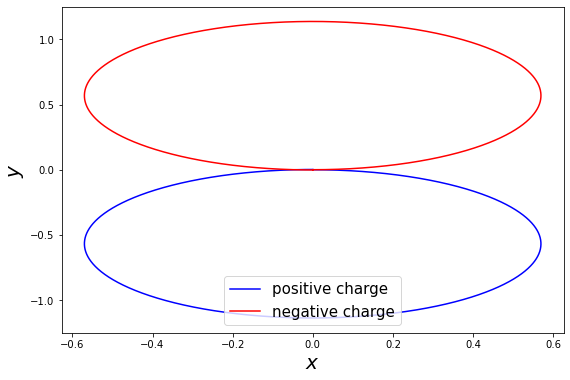
5. Visualising the magnetic field induced by a moving charge¶
5.a. Writing the induced field function¶
Function with particle as an argument¶
def induced_Bfield(pos, t, particle):
disp = pos - particle['pos'] # displacement vector from particle to position we're looking at
return (vperm*particle['charge']/(4*np.pi)) * cross(particle['vel'], disp)/dot(disp, disp)
Create a moving particle moving quickly along x axis¶
def get_xmoving_particle():
return {'charge' : echarge,
'mass' : emass,
'pos' : np.array([0.1, 0.1, 0.1]),
'vel' : np.array([1.0e26, 0.0, 0.0,])}
Get the field function in its usual form¶
xmoving_particle = get_xmoving_particle()
def Bfield_particle(pos, t):
return induced_Bfield(pos, t, xmoving_particle)
5.b. Visualise the induced field¶
grid = gen_grid(0, -2, -2, 2, 2, 0.2)
plot_Bfield(Bfield_particle, grid, 0)
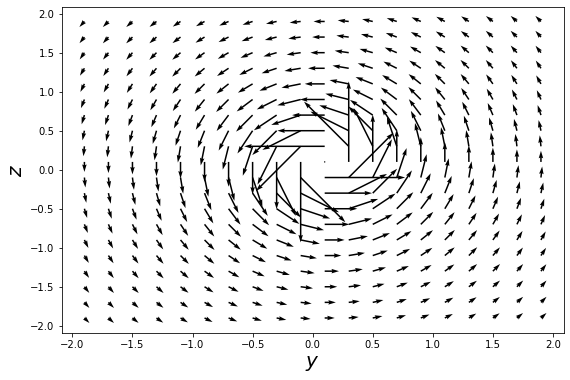
6. Gauss’s law for magnetism¶
6.a. and 6.b. Creating the cubic surface and area element vectors¶
Defining a function to create ‘oriented’ surfaces¶
def gen_oriented_grid(axis, orientation, coord1, coord2_0, coord3_0, coord2_max, coord3_max, dcoord):
grid = gen_grid(coord1, coord2_0, coord3_0, coord2_max, coord3_max, dcoord) # get a grid perpendicular to z axis
axis_i = {'x':0, 'y':1, 'z':2}[axis.lower()]
grid = [ point[[axis_i, (axis_i+1)%3, (axis_i+2)%3]] for point in grid ] # swap co-ords to make the grid perpendicular to chosen axis
dA_mag = dcoord**2 # get magnitude of area element
dA = np.array([0.0, 0.0, 0.0])
dA[axis_i] = np.sign(orientation)*dA_mag # get vector form of area element
return grid, dA
Define a function to calculate magnetic flux through a regular grid surface¶
def calculate_flux(Bfield_function, t, surface_points, surface_dA):
flux = 0.0
for point in surface_points:
flux += dot(Bfield_function(point, t), surface_dA)
return flux
Create a cube centred at the origin¶
xpos, dA_xpos = gen_oriented_grid('x', 1.0, 0.5, -0.5, -0.5, 0.5, 0.5, 0.001) # create the face on +ve x-axis
xneg, dA_xneg = gen_oriented_grid('x', -1.0, -0.5, -0.5, -0.5, 0.5, 0.5, 0.001) # create the face on -ve x-axis
ypos, dA_ypos = gen_oriented_grid('y', 1.0, 0.5, -0.5, -0.5, 0.5, 0.5, 0.001) # create the face on +ve y-axis
yneg, dA_yneg = gen_oriented_grid('y', -1.0, -0.5, -0.5, -0.5, 0.5, 0.5, 0.001) # create the face on -ve y-axis
zpos, dA_zpos = gen_oriented_grid('z', 1.0, 0.5, -0.5, -0.5, 0.5, 0.5, 0.001) # create the face on +ve z-axis
zneg, dA_zneg = gen_oriented_grid('z', -1.0, -0.5, -0.5, -0.5, 0.5, 0.5, 0.001) # create the face on -ve z-axis
6.c Calculating fluxes through the cube faces¶
flux_xpos = calculate_flux(Bfield_particle, 0.0, xpos, dA_xpos)
flux_xneg = calculate_flux(Bfield_particle, 0.0, xneg, dA_xneg)
flux_ypos = calculate_flux(Bfield_particle, 0.0, ypos, dA_ypos)
flux_yneg = calculate_flux(Bfield_particle, 0.0, yneg, dA_yneg)
flux_zpos = calculate_flux(Bfield_particle, 0.0, zpos, dA_zpos)
flux_zneg = calculate_flux(Bfield_particle, 0.0, zneg, dA_zneg)
Printing the results¶
print(f'The flux through the +ve x face is: {flux_xpos}')
print(f'The flux through the -ve x face is: {flux_xneg}')
flux_x = flux_xpos + flux_xneg
print(f'The total flux through the x faces is: {flux_x}')
print(f'The flux through the +ve y face is: {flux_ypos}')
print(f'The flux through the -ve y face is: {flux_yneg}')
flux_y = flux_ypos + flux_yneg
print(f'The total flux through the y faces is: {flux_y}')
print(f'The flux through the +ve z face is: {flux_zpos}')
print(f'The flux through the -ve z face is: {flux_zneg}')
flux_z = flux_zpos + flux_zneg
print(f'The total flux through the x faces is: {flux_z}')
flux = flux_x + flux_y + flux_z
print(f'The total flux through the cube surface is: {flux}')
The flux through the +ve x face is: 0.0
The flux through the -ve x face is: 0.0
The total flux through the x faces is: 0.0
The flux through the +ve y face is: -2.1294852298939033
The flux through the -ve y face is: -1.85747510863246
The total flux through the y faces is: -3.9869603385263632
The flux through the +ve z face is: 2.1294852298939033
The flux through the -ve z face is: 1.85747510863246
The total flux through the x faces is: 3.9869603385263632
The total flux through the cube surface is: 0.0
